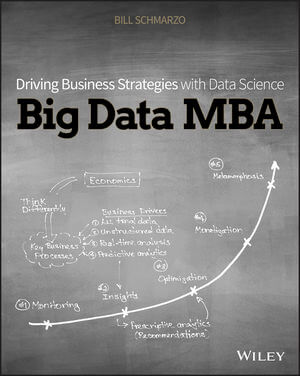
The Business of Big Data

Some claim that every business will eventually be data-driven. That is probably not too far from the truth (as long as you don’t quantify “eventually”). For some sectors, like retail and insurance, Big Data analytics is mostly just a next step for the business intelligence they are already doing. For other sectors, the introduction of Big Data analytics is a more fundamental step as the collecting and analyzing data is not yet done operationally.
What if you are, say, an engineering company with loads of experience in building complex installations but without any data science background. Where do you start? What are smart investments in terms of knowledge and infrastructure? How is Big Data going to make your company more competitive?
Big Data MBA
If this is the sort of questions that you are dealing with, one of the books that I’d recommend is Big Data MBA by Bill Schmarzo. It has a wonderful pragmatic approach to big data. The basic message is: start from the strategic goals that your company already has. What is your current strategy to make your company stand out from the competition? Answer this question from a business perspective, not from the point of view that you “have to do something with data”. For example, your engineering company may choose to compete by being able to finish projects faster. The strategic initiative could be to reduce construction time by 10% over the next 12 months.
Once you have identified the primary strategic initiatives of your company, determine what decisions will have to be made for implementing this initiative. In the example above, your company will have to identify the most important factors that determine the time spent on a project.
Only then you are ready to consider how data science can help you make the best possible decisions giving the best possible strategic result. For reducing the project time, you will probably want to collect data like the time needed for specific construction activities, the time spent waiting for materials or time lost due to bad weather. From this, you can identify those big data projects that will provide the highest benefit for your strategic goal and are most easy to realize in terms of data availability and analytics skills.
For me, the book was a relief to read. All too often the big data evangelists seem to say that you should just collect data and then go and find the value in it. I wouldn’t say that it cannot work this way (some well-known companies have gone this way), but it sounds like a pretty inefficient way to go. Schmarzo’s approach makes more sense to me. At least it is more easy to handle for traditional companies moving into the data age. The business case will be easy to make when you are close to what your company is doing anyway. And the immediate benefits will help you gain momentum to move on.
The Big Data Maturity scale
Moving on would mean: climbing on the Big Data Maturity scale that Bill Schmarzo defines.
The first few maturity levels are relatively easy. It starts with monitoring what you’re doing. Most companies already do some of that. But thinking about the strategic goals as above will probably identify things that are not yet monitored. We’ve seen some very interesting examples of that in our work at VORtech. In the example above, the time spent waiting for materials is perhaps not yet collected in a structural way. And the time lost due to bad weather is perhaps not yet linked to the time of the year or the location of the construction site.
The next maturity level is the level of insights: not just monitoring what you do, but also trying to gain an understanding of the underlying mechanisms (why is material late, why do we loose time due to bad weather in Scotland and not in Abu Dhabi). Then, there is the optimization level, where you are turning your insights into actionable recommendations (tell planners to order from provider X early, because they are always late; build facilities to keep out the rain when building in Scotland; and hopefully some less obvious recommendations).
The maturity levels beyond that are more advanced. They will have a bigger impact on your business but also require a more fundamental change. The first of these advanced levels is the monetization level, where you turn your data and insights into products or services that others will buy. The next and final level is the metamorphosis level, which entails a fundamental rethinking of your business. This is the level that Airbnb and Uber are on, as they are redefining the hotel and taxi business respectively.
Conclusion
If every business will eventually be data driven, then your company will have to get going on the Big Data Maturity scale. The first one that gets to the metamorphosis level in your line of business may well redefine the rules of competition in a way that drives everyone else out. So that had better be you. There are good consultants and data scientists available in specialized companies like VORtech. So what are you waiting for?